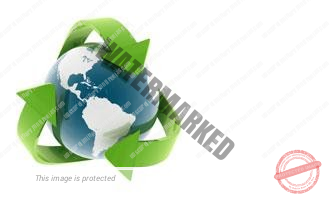- WASTE GENERATION AND MANAGEMENT
- MANAGEMENT STRATEGY – TREATMENT AND RECYCLE
UNIT 4 – ENVIRONMENTAL DEGRADATION – PART 13
4.6 WASTE GENERATION AND MANAGEMENT
Waste is defined as any unwanted or unusable substance that is discarded after primary use. Wastes are normally generated as a result of human and animal activities.
Urbanization and rapid advancements in industrialization has led to an increase in the production and consumption processes resulting in the generation of wastes from various sectors that include Agricultural, Commercial, Domestic, Industrial, And Institutional and from community activities. Over time, these wastes accumulate and can have real impacts on the health and the environmental degradation.
The problem of waste accumulation is becoming unmanageable with issues like Landfills, Solid Waste, Heaps of E –Waste Trade, River Collaging and Marine Garbage Patches. Hence Waste management is intended to reduce adverse effects of waste on health, the environment or aesthetics. The main three principles reduce, reuse, and recycle is the key to approach the environmental issue of waste management.
CLASSIFICATION OF WASTE
The waste generated from various sources is classified based on their properties e.g., Solid, Liquid and Gaseous. They are also classified based on their sources, like municipal waste, agricultural waste, biomedical waste etc. broadly from the environmental angle it is classified as biodegradable and non-biodegradable.
DIFFERENT TYPES OF WASTE
- SOLID WASTE- solid wastes include Waste Tires, Septage, Scrap Metal, Latex Paints, Furniture And Toys, Garbage, Appliances and vehicles, oil and anti-freeze, empty aerosol cans, paint cans and compressed gas cylinders, construction and Demolition Debris, Asbestos, Plastics, Styrofoam Containers, Bottles
- LIQUID WASTES: Liquid wastes can be defined as liquids/fluids that are generated from washing, flushing or manufacturing processes of the industries. They are also called as Sewage. Examples: domestic washings, chemicals, oils, waste water from ponds, Wastewater from manufacturing industries, manure, waste oil, fats, oils or grease (FOG), used oil, and hazardous household liquids.
- Gaseous waste – It is a waste product released in the form of gases from automobiles, factories, industries, burning of fossil fuels etc and gets mixed in the atmosphere. These gases include Carbon Monoxide, Carbon Dioxide, Sulphur Dioxide, Nitrogen Dioxide, Ozone and methane etc.
4.Municipal solid waste – Municipal solid waste (MSW) Municipal solid waste commonly referred to as trash, garbage or refuse comprises of street wastes, dead animals, market wastes, abandoned vehicles, household garbage, rubbish, construction and demolition debris, sanitation residue, packaging materials, trade refuges etc.
They are collected from residential houses, markets, streets, and other places mostly from urban areas and disposed of by municipal bodies. It is among the largest source of several types of pollution and landfill problems and necessitates Management Strategy – segregation at source, recycle, faecal sludge management, sewage treatment and safe disposal.
INDUSTRIAL EFFLUENTS– it is large amount of waste generated from the industrial activities. Some examples of industrial wastes are chemical solvents, paints, sandpaper, paper products, industrial by-products, metals, and radioactive wastes. Industrial solid wastes are further classified as hazardous and non-hazardous wastes. These are very hazardous and have to be treated mandatorily before letting into the nature.
MANAGEMENT STRATEGY – TREATMENT AND RECYCLE
- Agriculture wastes include both natural (organic) and non-natural wastes generated through farming activities. It includes spoiled food grains, vegetables, animal and plant wastes, litter, pesticides. Other agricultural wastes are produced from agricultural products processing industries like Sugarcane Factories, Tobacco Processing Units, Slaughterhouses, Livestock, Poultry etc.
Agricultural wastes are mostly biodegradable but few wastes like pesticide and fertilizers are toxic. These wastes add to the POP (persistent organic pollutants) and stay for million years.
Management Strategy – management and recycle at source, conversion into biogas and manure for further production.
- Biomedical wastes produced from hospitals, medical centres and nursing homes are called biomedical wastes. These wastes are highly infectious and may pose severe threat if not managed properly. Biomedical wastes may be solid or liquid that includes discarded blood, sharps, soiled wastes, disposables, anatomical wastes, cultures, discarded medicines, chemical wastes etc.
Management strategy – careful disposal, sanitation, fumigation, disinfection
8.Radioactive wastes Radioactive wastes are hazardous, by-products of nuclear reactions. They pose severe threat to human life and environment. Radioactive wastes decays over time ranging from a few days for highly radioactive isotopes to millions of years for slightly radioactive ones. Hence, these wastes have to be isolated and confined at appropriate disposal facilities for it to completely decay. The sources of radioactive wastes are from mining of radioactive substances, atomic explosion, nuclear fuel cycle, nuclear weapons reprocessing, medical and industrial wastes etc.
Management strategy – control in emissions and careful disposal
- E-waste – Electronic wasteor e-wastedescribes discarded electrical or electronic devices. Used electronics which are destined for refurbishment, reuse, resale, salvage recycling through material recovery, or disposal are also considered e-waste. Electronic scrap components, such as CPUs, contain potentially harmful materials such as lead, cadmium, beryllium, or brominated flame retardants. Informal processing of e-waste in developing countries can lead to adverse human health effects and environmental pollution.
Management strategy – reuse and recycle.

